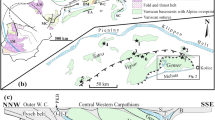Summary
¶Detailed studies of rocks from the Limpopo (South Africa) and Lapland (Kola-Fennoscandia) high-grade terrains were carried out in order to reveal similar geological and thermodynamic conditions in their formation. Both complexes (1) are situated between Archean greenstone belts, (2) are younger than the belts, (3) are bounded by crustal-scale shear zones, (4) have a similar intrusive-like (harpolith) geometry, and (5) show similar reaction textures that reflect both breakdown and growth of garnet in each high-grade terrain. Local mineral equilibria within the textures indicate their successive formation with cooling of the granulite facies rocks. Some of the textures in the metapelites must have resulted from the following reverse reactions: Grt + Qtz ⇌Opx + Crd and/or Grt + Sil + Qtz ⇌ Crd. Based on these data, both the decompression cooling P-T path and the near-isobaric cooling P-T path were deduced for each HGT. However the near-isobaric cooling P-T path is not a characteristic of the central zones of both complexes studied.
Similar structural framework of the high-grade terrains, similar morphologies (shapes of granulitic bodies), similar reaction textures developed in metapelites, and similar shapes of P-T paths suggest similarity in geodynamic history of both complexes.
Zusammenfassung
¶Vergleichende Petrologie und metamorphe Entwicklung der hochgradig metamorphen Terrains von Limpopo (Südafrika) und Lappland (Fennoscandia)
Eingehende Untersuchungen an Gesteinen aus den hochgradig metamorphen Terrains von Limpopo (Südafrika) und Lappland (Kola-Fennoscania) sollen mögliche Ähnlichkeiten in den geologischen und thermodynamischen Bildungsbedingungen aufzeigen.
Beide Komplexe sind
Lokale Mineralgleichgewichte innerhalb der Texturen weisen auf ihre schrittweise Bildung während der Abkühlung der granulitfaziellen Gesteine hin. Einige der Texturen in den Metapeliten gehen auf folgende reversible Reaktionen zurück: Grt + Qtz ⇌Opx + Crd und/oder Grt + Sil + Qtz ⇌ Crd. Diese Daten ermöglichten es, sowohl den P-T Pfad der Abkühlung bei Druckentlastung sowie den fast-isobaren P-T Pfad der Abkühlung für jedes HGT zu ermitteln. Der fast-isobare P-T Pfad der Abkühlung ist jedoch kein Charakteristikum der Zentralzonen beider Komplexe.
Ein ähnlicher struktureller Rahmen der hochgradigen Terrains, ähnliche Morphologien (Ausbildung der Granulitkörper), ähnliche Reaktionstexturen in Metapeliten und ähnliche P-T Pfade weisen auf Ähnlichkeiten der geodynamischen Entwicklungsgeschichte beider Komplexe hin.
Similar content being viewed by others
Author information
Authors and Affiliations
Additional information
Received March 8, 1999; revised version accepted September 17, 1999
Rights and permissions
About this article
Cite this article
Perchuk, L., Gerya, T., van Reenen, D. et al. Comparative petrology and metamorphic evolution of the Limpopo (South Africa) and Lapland (Fennoscandia) high-grade terrains. Mineralogy and Petrology 69, 69–107 (2000). https://doi.org/10.1007/s007100050019
Issue Date:
DOI: https://doi.org/10.1007/s007100050019




